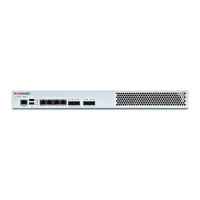System Configurations Administration
Function Page File Name
[Service > NAT] nat.txt
[Service > Persistent Routing] persistent-routing.txt
[Service > Auto Routing] auto-routing.txt
[Service > Virtual Server] virtual-server.txt
[Service > Bandwidth Management] bandwidth-management.txt
[Service > Connection Limit] connection-limit.txt
[Service > Cache Redirect] cache-redirect.txt
[Service > Multihoming] multihoming.txt
[Service > Internal DNS] Internal-nameserver.txt
[Service > SNMP] snmp.txt
[Service > IP-MAC Mapping] ip-mac-mapping.txt
[Service > DNS Proxy] dnsproxy.txt
[Service > Tunnel Routing] tunnel-routing.txt
[Log > Control] log-control.txt (This file includes Mail/FTP passwords.)
[Log > Notification] notification.txt (This file includes email/password)
[Log > Link Report] link-report.txt
Maintenance
Click [Factory Default] to reset configurations to factory default. Or you can perform “resetconfig” command in
console. Click [Reboot] to reboot FortiWAN. For information on console command, please refer to Console Mode
Commands.
Web UI Port
Type the port number in [New Port] and then click [Setport]. Enter the new port number when you log in again into
Web UI. Additionally, the new port shall avoid conflict with FortiWAN reserved ports when configuring the port.
Otherwise, FortiWAN will display error message of port settings failure and resume to the correct port number that was
configured last time.
77 FortiWAN Handbook
Fortinet Technologies Inc.

